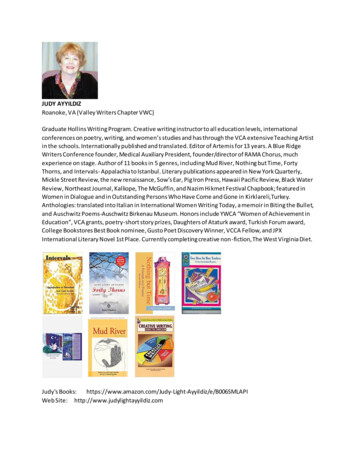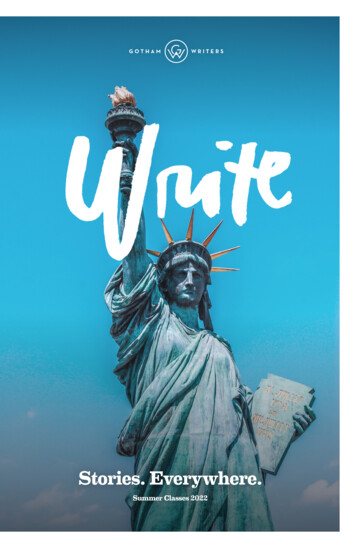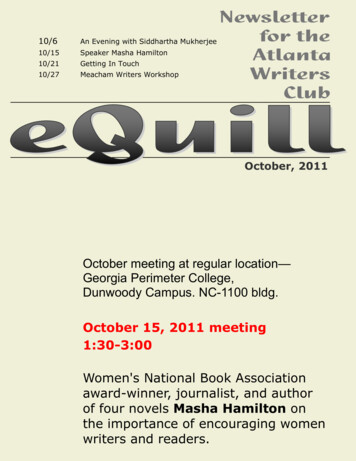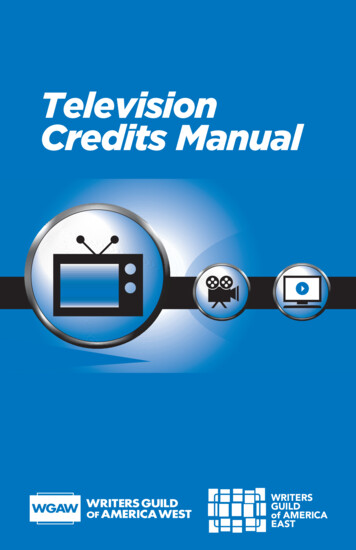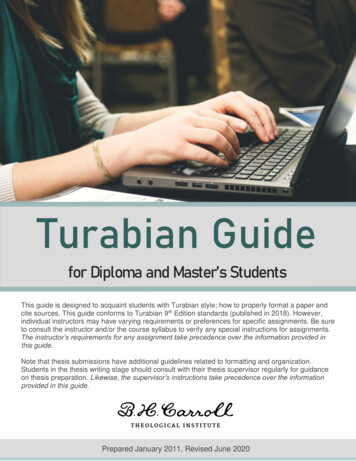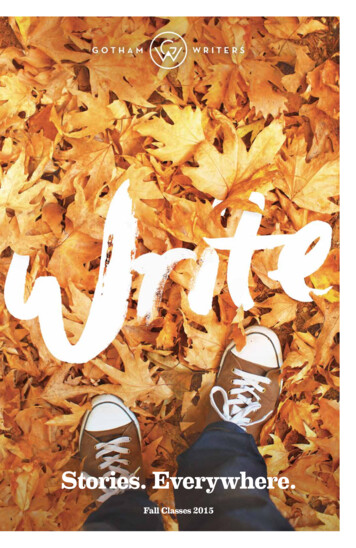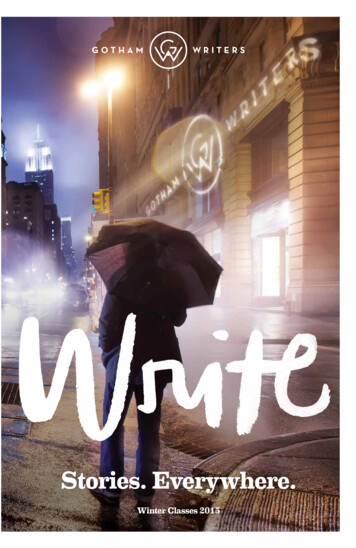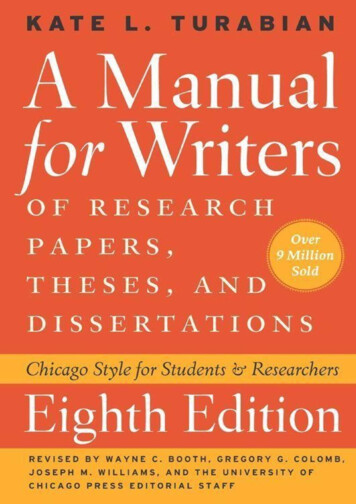
Transcription
Portions of this book have been adapted from The Craft of Research, 3rd edition, by Wayne C. Booth, Gregory C. Colomb, and Joseph M. Williams,2008 by The University of Chicago; and The Chicago Manual of Style, 16th edition, 2010 by The University of Chicago.1995, 2003,The University of Chicago Press, Chicago 60637The University of Chicago Press, Ltd., London2007, 2013 by The University of ChicagoAll rights reserved. Published 2013.Printed in the United States of America22 21 20 19 18 17 16 15 14 1312345ISBN-13: 978-0-226-81637-1 (cloth)ISBN-13: 978-0-226-81638-8 (paper)ISBN-13: 978-0-226-81639-5 (e-book)Library of Congress Cataloging-in-Publication DataTurabian, Kate L.A manual for writers of research papers, theses, and dissertations : Chicago Style for students and researchers / Kate L. Turabian ; revised by Wayne C. Booth,Gregory G. Colomb, Joseph M. Williams, and the University of Chicago Press editorial staff. Eighth edition.pages cm. (Chicago guides to writing, editing, and publishing)Portions of this book have been adapted from The Craft of Research, 3rd edition, by Wayne C. Booth, Gregory C. Colomb, and Joseph M. Williams, 1995, 2003,2008 by The University of Chicago; and The Chicago Manual of Style, 16th edition, 2010 by The University of Chicago title page verso.Includes bibliographical references and index.ISBN 978-0-226-81637-1 (cloth : alkaline paper) ISBN 978-0-226-81638-8 (paperback : alkaline paper) ISBN 978-0-226-81639-5 (e-book) I. Dissertations,Academic-Handbooks, manuals, etc. 2. Academic writing-Handbooks, manuals, etc. I. Booth, Wayne C. II. Colomb, Gregory G. III. Williams, Joseph M. IV. Title. V.Series: Chicago guides to writing, editing, and publishing.LB2369.TS 2013808.06 6378 dc232012036981This paper meets the requirements of ANSI/NISO Z39.48-1992 (Permanence of Paper).2
A Manual for Writers of Research Papers, Theses, andDissertationsChicago Style for Students and ResearchersKate L. Turabian8th EditionRevised byWayne C. Booth, Gregory G. Colomb, Joseph M. Williams, and the University of Chicago Press Editorial StaffThe University of Chicago PressChicago and London3
On Writing, Editing, and PublishingJacques BarzunTelling About SocietyHoward S. BeckerTricks of the TradeHoward S. BeckerWriting for Social ScientistsHoward S. BeckerWhat Editors WantPhilippa J. Benson and Susan C. SilverPermissions, A Survival GuideSusan M. BielsteinThe Craft of TranslationJohn Biguenet and Rainer Schulte, editorsThe Craft of ResearchWayne C. Booth, Gregory G. Colomb, and Joseph M. WilliamsThe Dramatic Writerʼs CompanionWill DunneGlossary of Typesetting TermsRichard Eckersley, Richard Angstadt, Charles M. Ellerston, Richard Hendel, Naomi B. Pascal, and Anita Walker ScottWriting Ethnographic FieldnotesRobert M. Emerson, Rachel I. Fretz, and Linda L. ShawLegal Writing in Plain EnglishBryan A. GarnerFrom Dissertation to BookWilliam GermanoGetting It PublishedWilliam GermanoThe Craft of Scientific CommunicationJoseph E. Harmon and Alan G. GrossStorycraftJack HartA Poetʼs Guide to PoetryMary KinzieThe Chicago Guide to Collaborative EthnographyLuke Eric LassiterHow to Write a BA Thesis4
Charles LipsonCite RightCharles LipsonThe Chicago Guide to Writing about Multivariate AnalysisJane E. MillerThe Chicago Guide to Writing about NumbersJane E. MillerMapping It OutMark MonmonierThe Chicago Guide to Communicating ScienceScott L. MontgomeryIndexing BooksNancy C. MulvanyDevelopmental EditingScott NortonGetting into PrintWalter W. PowellThe Subversive Copy EditorCarol Fisher SallerA Manual for Writers of Research Papers, Theses, and DissertationsKate L. TurabianStudentʼs Guide for Writing College PapersKate L. TurabianTales of the FieldJohn Van MaanenStyleJoseph M. WilliamsA Handbook of Biological IllustrationFrances W. Zweifel5
ContentsA Note to StudentsPrefacePart IResearch and Writing: From Planning to ProductionWayne C. Booth, Gregory G. Colomb, and Joseph M. WilliamsOverview of Part I1What Research Is and How Researchers Think about It1.1 How Researchers Think about Their Aims1.2 Three Kinds of Questions That Researchers Ask2Moving from a Topic to a Question to a Working Hypothesis2.1 Find a Question in Your Topic2.2 Propose Some Working Answers2.3 Build a Storyboard to Plan and Guide Your Work2.4 Organize a Writing Support Group3Finding Useful Sources3.1 Understand the Kinds of Sources Readers Expect You to Use3.2 Record Your Sources Fully, Accurately, and Appropriately3.3 Search for Sources Systematically3.4 Evaluate Sources for Relevance and Reliability3.5 Look beyond the Usual Kinds of References4Engaging Sources4.1 Read Generously to Understand, Then Critically to Engage and Evaluate4.2 Take Notes Systematically4.3 Take Useful Notes4.4 Write as You Read4.5 Review Your Progress4.6 Manage Moments of Normal Panic5Planning Your Argument5.1 What a Research Argument Is and Is Not5.2 Build Your Argument around Answers to Readers Questions5.3 Turn Your Working Hypothesis into a Claim5.4 Assemble the Elements of Your Argument5.5 Distinguish Arguments Based on Evidence from Arguments Based on Warrants5.6 Assemble an Argument6Planning a First Draft6.1 Avoid Unhelpful Plans6.2 Create a Plan That Meets Your Readers Needs6.3 File Away Leftovers7Drafting Your Report7.1 Draft in the Way That Feels Most Comfortable7.2 Develop Productive Drafting Habits7.3 Use Your Key Terms to Keep Yourself on Track7.4 Quote, Paraphrase, and Summarize Appropriately7.5 Integrate Quotations into Your Text7.6 Use Footnotes and Endnotes Judiciously6
7.7 Interpret Complex or Detailed Evidence Before You Offer It7.8 Be Open to Surprises7.9 Guard against Inadvertent Plagiarism7.10 Guard against Inappropriate Assistance7.11 Work Through Chronic Procrastination and Writer s Block8Presenting Evidence in Tables and Figures8.1 Choose Verbal or Visual Representations8.2 Choose the Most Effective Graphic8.3 Design Tables and Figures8.4 Communicate Data Ethically9Revising Your Draft9.1 Check for Blind Spots in Your Argument9.2 Check Your Introduction, Conclusion, and Claim9.3 Make Sure the Body of Your Report Is Coherent9.4 Check Your Paragraphs9.5 Let Your Draft Cool, Then Paraphrase It10Writing Your Final Introduction and Conclusion10.1 Draft Your Final Introduction10.2 Draft Your Final Conclusion10.3 Write Your Title Last11Revising Sentences11.1 Focus on the First Seven or Eight Words of a Sentence11.2 Diagnose What You Read11.3 Choose the Right Word11.4 Polish It Up11.5 Give It Up and Print It Out12Learning from Your Returned Paper12.1 Find General Principles in Specific Comments12.2 Talk to Your Instructor13Presenting Research in Alternative Forums13.1 Plan Your Oral Presentation13.2 Design Your Presentation to Be Listened To13.3 Plan Your Poster Presentation13.4 Plan Your Conference Proposal14Part II15On the Spirit of ResearchSource CitationGeneral Introduction to Citation Practices15.1 Reasons for Citing Your Sources15.2 The Requirements of Citation15.3 Two Citation Styles15.4 Electronic Sources15.5 Preparation of Citations15.6 Citation Management Software16Notes-Bibliography Style: The Basic Form16.1 Basic Patterns16.2 Bibliographies16.3 Notes7
16.4 Short Forms for Notes17Notes-Bibliography Style: Citing Specific Types of Sources17.1 Books17.2 Journal Articles17.3 Magazine Articles17.4 Newspaper Articles17.5 Additional Types of Published Sources17.6 Unpublished Sources17.7 Websites, Blogs, Social Networks, and Discussion Groups17.8 Sources in the Visual and Performing Arts17.9 Public Documents17.10 One Source Quoted in Another18Author-Date Style: The Basic Form18.1 Basic Patterns18.2 Reference Lists18.3 Parenthetical Citations19Author-Date Style: Citing Specific Types of Sources19.1 Books19.2 Journal Articles19.3 Magazine Articles19.4 Newspaper Articles19.5 Additional Types of Published Sources19.6 Unpublished Sources19.7 Websites, Blogs, Social Networks, and Discussion Groups19.8 Sources in the Visual and Performing Arts19.9 Public Documents19.10 One Source Quoted in AnotherPart III20StyleSpelling20.1 Plurals20.2 Possessives20.3 Compounds and Words Formed with Prefixes20.4 Line Breaks21Punctuation21.1 Periods21.2 Commas21.3 Semicolons21.4 Colons21.5 Question Marks21.6 Exclamation Points21.7 Hyphens and Dashes21.8 Parentheses and Brackets21.9 Slashes21.10 Quotation Marks21.11 Apostrophes21.12 Multiple Punctuation Marks22Names, Special Terms, and Titles of Works22.1 Names8
22.2 Special Terms22.3 Titles of Works23Numbers23.1 Words or Numerals?23.2 Plurals and Punctuation23.3 Date Systems23.4 Numbers Used outside the Text24Abbreviations24.1 General Principles24.2 Names and Titles24.3 Geographical Terms24.4 Time and Dates24.5 Units of Measure24.6 The Bible and Other Sacred Works24.7 Abbreviations in Citations and Other Scholarly Contexts25Quotations25.1 Quoting Accurately and Avoiding Plagiarism25.2 Incorporating Quotations into Your Text25.3 Modifying Quotations26Tables and Figures26.1 General Issues26.2 Tables26.3 FiguresAppendix: Paper Format and SubmissionA.1 General Format RequirementsA.2 Format Requirements for Specific ElementsA.3 File Preparation and Submission RequirementsBibliographyAuthorsIndex9
A Note to StudentsA Manual for Writers of Research Papers, Theses, and Dissertations has helped generations of students successfully research, write,and submit papers in virtually all academic disciplines. Most commonly known as Turabian, in honor of the original author, thisbook is the authoritative student resource on Chicago style.Part I covers every step of the research and writing process and provides practical advice to help you formulate the rightquestions, read critically, and build arguments. It also shows you how to draft and revise your papers to strengthen both yourarguments and your writing. Part 2 offers a comprehensive guide to Chicago s two methods of source citation, beginning with helpfulinformation on general citation practices in chapter 15. In the humanities and most social sciences, you will likely use the notesbibliography style detailed in chapters 16 and 17; in the natural and physical sciences and some social sciences, you will more likelyuse the author-date (also called parenthetical citations-reference list) style described in chapters 18 and 19. Part 3 covers Chicago srecommended editorial style, which will help you bring consistency to your writing in matters such as punctuation, capitalization,and abbreviations; this section also includes guidance on incorporating quotations into your writing and on properly presentingtables and figures. The appendix presents formatting and submission requirements for theses and dissertations that many academicinstitutions use as a model, but be sure to follow any local guidelines provided by your institution.10
PrefaceStudents writing research papers, theses, and dissertations in today s colleges and universities inhabit a world filled with electronictechnologies that were unimagined in 1937 the year dissertation secretary Kate L. Turabian first assembled a booklet of guidelinesfor student writers at the University of Chicago. The availability of word-processing software and new digital sources has changed theway students conduct research and write up the results. But these technologies have not altered the basic task of the student writer:doing well-designed research and presenting it clearly and accurately, while following accepted academic standards for citation,style, and format.Turabian s 1937 booklet reflected guidelines found in A Manual of Style, tenth edition an already classic resource for writersand editors published by the University of Chicago Press. The Press began distributing Turabian s booklet in 1947 and first publishedthe work in book form in 1955, under the title A Manual for Writers of Term Papers, Theses, and Dissertations. Turabian revised thework twice more, updating it to meet students needs and to reflect the latest recommendations of the Manual of Style. Over time,Turabian s book has become a standard reference for students of all levels at universities and colleges across the country. Turabiandied in 1987 at age ninety-four, a few months after publication of the fifth edition. For that edition, as well as the sixth (1996) andseventh (2007), members of the Press editorial staff carried out the revisions. For the seventh edition, Wayne C. Booth, Gregory G.Colomb, and Joseph M. Williams expanded the focus of the book by adding extensive new material adapted from their book TheCraft of Research, now in its third edition (Chicago: University of Chicago Press, 2008). Among the new topics covered were thenature of research, finding and engaging sources, taking notes, developing an argument, drafting and revising, and presentingevidence in tables and figures.For this new eighth edition, part I offers updated coverage on finding and using the many types of digital sources that havebecome available in recent years. Part 2 offers a comprehensive guide to the two Chicago styles of source citation the notesbibliography format used widely in the humanities and most social sciences and the author-date format favored in many of thesciences and some social sciences. In addition to making the two citation systems more consistent stylistically, this edition offersmany examples for citing new types of digital sources not previously covered. Part 3 addresses matters of spelling, punctuation,abbreviation, and treatment of numbers, names, special terms, and titles of works. The final two chapters in this section treat themechanics of using quotations and graphics (tables and figures), topics that are discussed from a rhetorical perspective in part I.Both parts 2 and 3 have been updated for this edition in accordance with the sixteenth edition of The Chicago Manual of Style(Chicago: University of Chicago Press, 2010), or CMOS. The recommendations in this manual in some instances diverge from CMOSin small ways, to better suit the requirements of academic papers as opposed to published works.The appendix presents guidelines for paper format and submission that have become the primary authority for dissertationoffices throughout the United States. As revised, these guidelines now reflect the increasing trend toward electronic submission ofpapers. This appendix is intended primarily for students writing PhD dissertations and master s and undergraduate theses, but thesections on format requirements and electronic file preparation will also aid those writing class papers. An extensive bibliography,organized by subject area, lists current sources for research and style issues specific to various disciplines.The guidelines in this manual offer practical solutions to a wide range of issues encountered by student writers, but they may besupplemented or even overruled by the conventions of specific disciplines or the preferences of particular institutions ordepartments. All of the chapters on style and format remind students to review the requirements of their university, department, orinstructor, which take precedence over the guidelines presented here.Updating a book that has been used by millions of students over seventy-five years is no small task, and many people participatedin preparing the eighth edition. Greg Colomb initiated the revision, and his death during the latter stages of the effort was a greatloss. Over the years, many Press staff members came to know Greg well and to treasure their relationship with him. He will bemissed. Greg was the remaining member of the remarkable trio of authors that also included Wayne Booth and Joe Williams.Although they are gone from us, their work will continue to carry the firm, encouraging guidance that has been the hallmark ofTurabian s manual. The one voice that they so artfully melded out of their three will always animate this work.Jon D Errico, Greg s longtime friend and colleague at the University of Virginia, completed the work on part I that Greg hadbegun for this edition. Russell David Harper, the principal reviser of the sixteenth edition of The Chicago Manual of Style, producedthe initial drafts of the remaining manuscript. Within the Press, the project was developed, in part and in whole, under the guidanceof Jenny Gavacs, Mary E. Laur, David Morrow, and Paul Schellinger.The appendix benefited from the generous advice of experts from a range of colleges, universities, and institutions: MatthewBoots of Indiana University; Ginny Borst of the University of Colorado Boulder; Philippa Carter of the University of Pittsburgh;Melissa Gomis of the University of Michigan; Peggy Harrell of the University of Southern Indiana; Elena Hsu of the University ofWisconsin Madison; Jerett Lemontt of the University of California, Berkeley; Gail MacMillan of the Virginia Polytechnic Instituteand State University; Austin Mclean of ProQuest/UMI; Colleen Mullarkey of the University of Chicago; Bob Penman of theUniversity of Texas at Austin; Laura Ryman of James Madison University; Tim Watson of the Ohio State University; and MarkZulauf of the University of Illinois at Urbana-Champaign. A team of librarians from the Regenstein Library at the University ofChicago provided guidance for the extensive bibliography: Scott Landvatter, Catherine Mardikes, Nancy Spiegel, Sarah G. Wenzel,and Christopher Winters.Turning the manuscript into a book required the efforts of another team at the Press. Ruth Goring edited the manuscript, RosinaBusse proofread the pages, and Mary E. Laur prepared the index. Michael Brehm provided the design, while David O Connorsupervised the production. Liz Fischer, Ellen Gibson, and Carol Kasper brought the final product to market.The University of Chicago Press Editorial Staff11
ResearchandWritingPart IFrom Planningto ProductionWayne C. Booth,Gregory G. Colomb,& Joseph M. Williams12
13
14
Overview of Part IWe know how challenged you can feel when you start a substantial research project, whether it s a PhD dissertation, a BA ormaster s thesis, or just a long class paper. But you can handle any project if you break it into its parts, then work on them one step ata time. This part shows you how to do that.We first discuss the aims of research and what readers will expect of any research report. Then we focus on how to find a researchquestion whose answer is worth your time and your readers attention; how to find and use information from sources to back upyour answer; and then how to plan, draft, and revise your report so your readers will see that your answer is based on soundreasoning and reliable evidence.Several themes run through this part. You can t plunge into a project blindly; you must plan it, then keep the whole process in mind as you take each step. So think big,but break the process down into small goals that you can meet one at a time. Your best research will begin with a question that you want to answer. But you must then imagine readers asking a question oftheir own: So what if you don t answer it? Why should I care? From the outset, you should try to write every day, not just to take notes on your sources but to clarify what you think of them. Youshould also write down your own developing ideas to get them out of the cozy warmth of your head into the cold light of day,where you can see if they still make sense. You probably won t use much of this writing in your final draft, but it is essentialpreparation for it. No matter how carefully you do your research, readers will judge it by how well you report it, so you must know what they will lookfor in a clearly written report that earns their respect.If you re an advanced researcher, skim chapters 1 4. You will see there much that s familiar; but if you re also teaching, it mayhelp you explain what you know to your students more effectively. Many experienced researchers report that chapters 5 12 havehelped them not only to explain to others how to conduct research and report it, but also to draft and revise their own reports morequickly and effectively.If you re just starting your career in research, you ll find every chapter of part 1 useful. Skim it all for an overview of the process;then as you work through your project, reread chapters relevant to your immediate task.You may feel that the steps described here are too many to remember, but you can manage them if you take them one at a time,and as you do more research, they ll become habits of mind. Don t think, however, that you must follow these steps in exactly theorder we present them. Researchers regularly think ahead to future steps as they work through earlier ones and revisit earlier stepsas they deal with a later one. (That explains why we so often refer you ahead to anticipate a later stage in the process and back torevisit an earlier one.) And even the most systematic researcher has unexpected insights that send her off in a new direction. Workfrom a plan, but be ready to depart from it, even to discard it for a new one.If you re a very new researcher, you may also think that some matters we discuss are beyond your immediate needs. We knowthat a ten-page class paper differs from a PhD dissertation. But both require a kind of thinking that even the newest researcher canstart practicing. You begin your journey toward full competence when you not only know what lies ahead but can also start practicingthe skills that experienced researchers began to learn when they were where you are now.No book can prepare you for every aspect of every research project. And this one won t help you with the specific methodologiesin fields such as psychology, economics, and philosophy, much less physics, chemistry, and biology. Nor does it tell you how to adaptwhat you learn about academic research to business or professional settings.But it does provide an overview of the processes and habits of mind that underlie all research, wherever it s done, and of theplans you must make to assemble a report, draft it, and revise it. With that knowledge and help from your teachers, you ll come tofeel in control of your projects, not intimidated by them, and eventually you ll learn to manage even the most complex projects onyour own, in both the academic and the professional worlds.The first step in learning the skills of sound research is to understand how experienced researchers think about its aims.15
1What Research Is and How Researchers Think about It1.1How Researchers Think about Their Aims1.2Three Kinds of Questions That Researchers Ask1.2.11.2.21.2.31.2.41.2.5Conceptual Questions: What Should We Think?Practical Questions: What Should We Do?Applied Questions: What Must We Understand Before We Know What to Do?Choosing the Right Kind of QuestionThe Special Challenge of Conceptual Questions: Answering So What?You do research every time you ask a question and look for facts to answer it, whether the question is as simple as finding a plumberor as profound as discovering the origin of life. When only you care about the answer or when others need just a quick report of it,you probably won t write it out. But you must report your research in writing when others will accept your claims only after theystudy how you reached them. In fact, reports of research tell us most of what we can reliably believe about our world that oncethere were dinosaurs, that germs cause disease, even that the earth is round.You may think your report will add little to the world s knowledge. Maybe so. But done well, it will add a lot to yours and to yourability to do the next report. You may also think that your future lies not in scholarly research but in business or a profession. Butresearch is as important outside the academy as in, and in most ways it is the same. So as you practice the craft of academic researchnow, you prepare yourself to do research that one day will be important at least to those you work with, perhaps to us all.As you learn to do your own research, you also learn to use and judge that of others. In every profession, researchers mustread and evaluate reports before they make a decision, a job you ll do better only after you ve learned how others will judge yours.This book focuses on research in the academic world, but every day we read or hear about research that can affect our lives. Beforewe believe those reports, though, we must think about them critically to determine whether they are based on evidence andreasoning that we can trust.To be sure, we can reach good conclusions in ways other than through reasons and evidence: we can rely on tradition andauthority or on intuition, spiritual insight, even on our most visceral emotions. But when we try to explain to others not just why webelieve our claims but why they should too, we must do more than just state an opinion and describe our feelings.That is how a research report differs from other kinds of persuasive writing: it must rest on shared facts that readers accept astruths independent of your feelings and beliefs. They must be able to follow your reasoning from evidence that they accept to theclaim you draw from it. Your success as a researcher thus depends not just on how well you gather and analyze data but on howclearly you report your reasoning so that your readers can test and judge it before making your claims part of their knowledge andunderstanding.1.1 How Researchers Think about Their AimsAll researchers gather facts and information, what we re calling data. But depending on their aims and experience, they use thosedata in different ways. Some researchers gather data on a topic stories about the Battle of the Alamo, for example just to satisfy apersonal interest (or a teacher s assignment).Most researchers, however, want us to know more than just facts. So they don t look for just any data on a topic; they look forspecific data that they can use as evidence to test and support an answer to a question that their topic inspired them to ask, such aswhy has the Alamo story become a national legend?Experienced researchers, however, know that they must do more than convince us that their answer is sound. They must alsoshow us why their question was worth asking, how its answer helps us understand some bigger issue in a new way. If we can figureout why the Alamo story has become a national legend, we might then answer a larger question: how have regional myths shaped ournational character?You can judge how closely your thinking tracks that of an experienced researcher by describing your project in a sentence likethis:1. I am working on the topic X (stories about the Battle of the Alamo)2. because I want to find out Y (why its story became a national legend)3. so that I can help others understand Z (how such regional myths have shaped our national character).That sentence is worth a close look, because it describes not just the progress of your research but your personal growth as aresearcher.1. I am working on the topicResearchers often begin with a simple topic like the Battle of the Alamo, perhaps because it wasassigned, because something about it puzzles them, or because it merely sparks an interest. But inexperienced researchers toooften stop there, leaving themselves with nothing but a topic to guide their work. They mound up hundreds of notes but have noway to decide what data to keep and what to discard. When it comes time to write, they dump everything into a report that readslike a grab bag of random facts. If those facts are new to readers who happen to be interested in the topic, they might read the16
report. But even those readers will want to know what those facts add up to.because I want to find out how or whyMore experienced researchers usually begin not with just a topic but with a researchquestion, such as Why has the story of the Alamo become a national legend? And they know that readers will think their facts addup to something only when those facts serve as evidence to support its answer. Indeed, only with a question can a researcherknow which facts to look for and which to keep not just those that support an answer but also those that test or even discredit it.When he thinks he has enough evidence to support his answer and can respond to data that seem to contradict it, he writes areport first to test his own thinking, then to share his answer with others so that they can test it too.3.so that I can help others understandThe most successful researchers, however, realize that readers want to know not onlythat an answer is sound but why the question was worth asking. So they anticipate that readers will ask a question of their own:So what? Why should I care why the Alamo story has become a legend? That So what? can vex even the most experiencedresearcher, but every researcher must try to answer it before it s asked: If we can find that out, we might better understand thebigger question of how such stories shape our national character.2.But a shrewd researcher doesn t stop there. She anticipates her readers asking So what? again by looking for another, still largeranswer: And if we can understand what has shaped our national character, we might understand better who we Americans think weare. And before you ask, when we know that, we might better understand why others in the world judge us as they do. The mostsuccessful researchers know that readers care about a question only when they think that its answer might encourage them to say notSo what? but That s worth knowing!In short, not all questions are equally good. We might ask how many cats slept in the Alamo the night before the battle, but sowhat if we find out? It is hard to see how an answer would help us think about any larger issue worth understanding, so it s aquestion that s probably not worth asking (though as we ll see, we could be wrong about that).1.2 Three Kinds of Questions That Researchers AskExperienced researchers also know that different readers expect them to ask and answer different kinds of questions. The mostcommon questions
A Manual for Writers of Research Papers, Theses, and Dissertations has helped generations of students successfully research, write, and submit papers in virtually all academic disciplines. Most commonly known as Turabian, in honor of the original author, this boo
